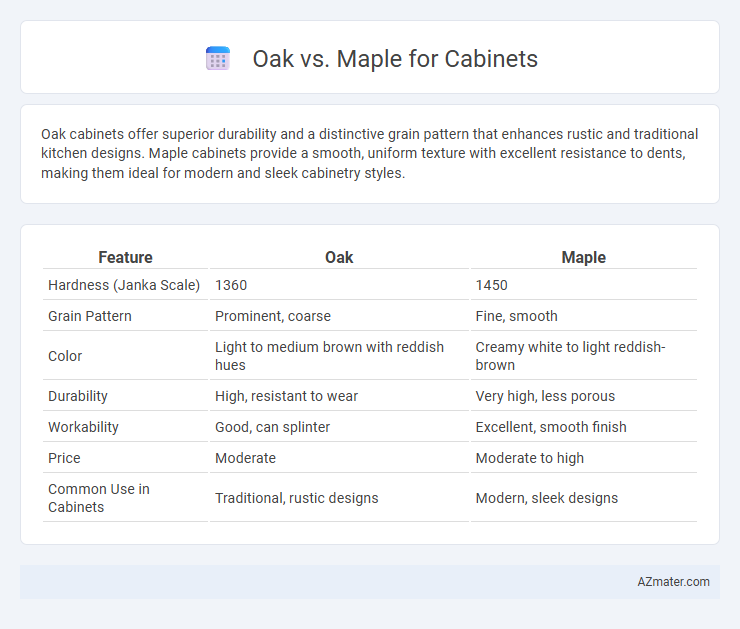Oak cabinets offer superior durability and a distinctive grain pattern that enhances rustic and traditional kitchen designs. Maple cabinets provide a smooth, uniform texture with excellent resistance to dents, making them ideal for modern and sleek cabinetry styles.
Table of Comparison
| Feature | Oak | Maple |
|---|---|---|
| Hardness (Janka Scale) | 1360 | 1450 |
| Grain Pattern | Prominent, coarse | Fine, smooth |
| Color | Light to medium brown with reddish hues | Creamy white to light reddish-brown |
| Durability | High, resistant to wear | Very high, less porous |
| Workability | Good, can splinter | Excellent, smooth finish |
| Price | Moderate | Moderate to high |
| Common Use in Cabinets | Traditional, rustic designs | Modern, sleek designs |
Introduction to Oak and Maple Cabinets
Oak cabinets offer durability and a distinct grain pattern that enhances traditional and rustic kitchen designs, prized for their strength and resistance to wear. Maple cabinets provide a smooth, fine grain with a light, uniform appearance, making them ideal for contemporary and transitional styles requiring a clean, consistent look. Both hardwoods are favored for cabinetry due to their stability and ability to accept various finishes, ensuring long-lasting functionality and aesthetic appeal.
Appearance and Grain Patterns
Oak cabinets showcase prominent, coarse grain patterns with a traditional, rustic appearance, often featuring visible rays and knots that add character and texture. Maple cabinets offer a smoother, more uniform grain with a fine texture, presenting a sleek and contemporary look that highlights subtle grain variations and soft, consistent coloration. Both woods provide durability, but oak's bold pattern contrasts sharply with maple's understated elegance, influencing the overall aesthetic in kitchen or furniture design.
Color Variations and Finishes
Oak cabinets offer a wide range of color variations from light golden hues to deep reddish-browns, showcasing its prominent grain patterns that complement both traditional and contemporary finishes. Maple cabinets feature a smoother, more uniform grain with natural colors ranging from creamy white to light reddish tones, making them ideal for sleek and modern finishes such as high-gloss or painted surfaces. Both woods accept stains and finishes well, but oak's open grain tends to highlight color depth, while maple's tight grain provides a smooth canvas for even, consistent finishes.
Durability and Strength Comparison
Oak cabinets offer superior durability and strength due to their dense hardwood structure, making them highly resistant to dents and scratches. Maple also provides excellent strength but is slightly softer than oak, resulting in better shock absorption but less resistance to wear over time. Both woods are suitable for cabinetry, but oak is preferred for high-traffic areas requiring maximum durability.
Cost Differences: Oak vs Maple
Oak cabinets typically cost less than maple due to the faster growth rate and wider availability of oak trees, making oak a more budget-friendly option for homeowners. Maple's denser grain and smoother finish contribute to higher manufacturing costs, resulting in a price premium compared to oak cabinets. The price difference between oak and maple cabinets can range from 10% to 25%, depending on the quality, finish, and region.
Maintenance and Cleaning Needs
Oak cabinets require regular dusting and occasional polishing due to their porous grain, which can trap dirt and stains more easily, making maintenance slightly more demanding. Maple cabinets feature a smoother, tighter grain, resisting dirt and grime better and allowing for easier cleaning with mild soap and water. Both woods benefit from avoiding harsh chemicals and excessive moisture to maintain their finish and durability over time.
Suitability for Different Kitchen Styles
Oak cabinets deliver a classic, durable option with its pronounced grain and warm tones, making them ideal for traditional and rustic kitchen styles. Maple offers a smooth, fine grain with a light, uniform color palette, perfectly complementing modern, minimalist, and contemporary kitchen designs. Both woods are versatile, but oak emphasizes texture and richness, while maple highlights sleekness and subtle elegance in cabinetry.
Pros and Cons of Oak Cabinets
Oak cabinets offer exceptional durability and a prominent grain pattern that adds character and warmth to kitchens, making them ideal for traditional or rustic designs. Their hardness ensures resistance to dents and scratches, but the pronounced grain can sometimes make seams and imperfections more noticeable. Oak's natural color ranges from light to medium brown, providing versatility for staining, though it may yellow over time if exposed to excessive sunlight.
Pros and Cons of Maple Cabinets
Maple cabinets offer a smooth, uniform grain that provides a versatile and modern appearance, making them ideal for diverse kitchen styles. Their durability resists dents and scratches better than many hardwoods, but softer than oak, meaning they may show wear more quickly in high-traffic areas. While maple's lighter color enhances bright and contemporary spaces, it can be prone to yellowing over time if exposed to direct sunlight.
Which is Better: Oak or Maple for Cabinets?
Oak offers exceptional durability and prominent grain patterns, making it ideal for traditional and rustic cabinet designs. Maple features a smoother texture and lighter color, providing a sleek, modern look with excellent resistance to wear and dents. Choosing between oak and maple depends on whether the priority is on bold aesthetics and hardness (oak) or a subtle, refined appearance with smooth grain and resilience (maple).

Infographic: Oak vs Maple for Cabinet
 azmater.com
azmater.com